Happy New Year: But First, Our Favorite Stories Of 2022
Happy New Year! As we say goodbye to 2022 – let’s face it: It could have been so much worse! – here are some of our favorite print pieces from the year and look forward to us all having a happy 2023.
JANUARY: Wildlife Photographer Gary Kramer’s Impact On Waterfowl
Born and raised in California, Kramer’s passion for the outdoors took root at an early age. Starting in the late 1970s, he landed a job as a wildlife biologist for the U.S. Fish and Wildlife Service’s Pacific Southwest Region in the Golden State.
Kramer worked on four national wildlife refuges over the next 26 years, including a 10-year stint as refuge manager of the Sacramento Nation- al Wildlife Refuge Complex. There, he made unprecedented changes and impacts that resulted in attracting the highest concentration of waterfowl on any refuge complex in the U.S.
If you’ve driven through some of these refuges watching or photograph- ing ducks and geese, you know what Kramer did. Strategically placed logs and habitat, clever road designs for good morning and evening light angles, and bringing in gravel that allows birds to stand and gather grit, are just some of the strides he made that benefited birds and waterfowl enthusiasts.

KRAMER’S LATEST PROJECT COULD be his most spectacular of all, as he recently completed a nearly four-year journey to more than 40 countries in which he photographed 165 of the 167 waterfowl species in the world. No one has ever accomplished this, let alone captured such stunning images that are highlighted in his latest book, Waterfowl of the World.
Kramer has always been a stickler for composing shots with perfect lighting in natural habitats at unique angles that make viewers feel as if they are there. Kramer ventured into the native habitat and some of the most remote corners of the world to get the highest-quality images possible for this project. -Scott Haugen
FEBRUARY: A Lifeline For Central Valley Chinook
With 600,000 fish successfully released on the first try on December 17, Galyean said even he was a little amazed by how well the fish adjusted right away to the river.
“I was really surprised at how well the fry swam immediately,” he said. “Most of the time when you put them in a raceway, they go straight to the bottom and they try to ball up in safety. I watched the fry swim back in towards the boat ramp, some swim up the very shallow current in the river – so they were more active. I take that as a good thing – that they were already able to swim and navigate.”
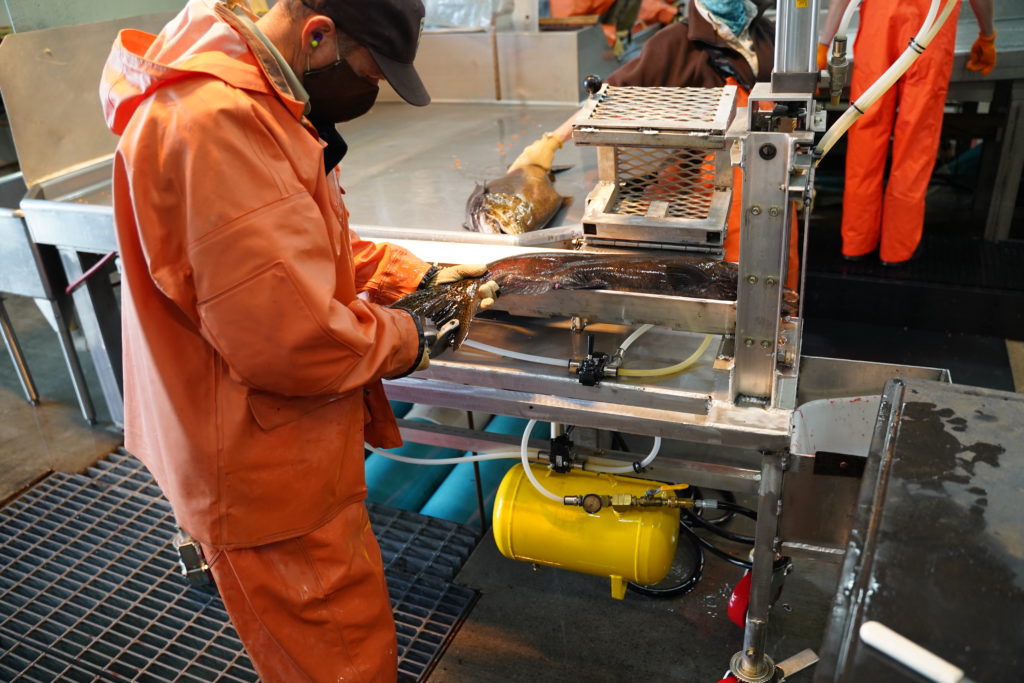
DENNIS WHITAKER/GOLDEN STATE SALMON ASSOCIATION
THE PROJECT BEGAN AFTER the Golden State Salmon Association and Nor-Cal Guides and Sportsmen’s Association proposed the idea to USFWS and NOAA-Fisheries in the spring of 2021.
From there, the process started with spawning of male and female fish for three consecutive days – a total of 525 fish. During that process each fish was fin punched (tissue sample taken) for genetic sampling. That way, when the adult fish return in late 2023, biologists
will be able to match genetics to the database to begin to determine success.
“It is a little nerdy and CSI-like,” Galyean said of the DNA process.
After spawning, biologists have the painstaking efforts of enumeration, which involves removing the dead eggs from the live ones to prevent fungus from suffocating the good eggs. This is done two months after spawning in a stage called “eyed,” when they begin to develop eyeballs.
“This is another example of the Cole- man National Fish Hatchery trying to develop different tactics to increase salmon runs back to the north state,” Galyean said. “Another tool in the toolbox.” -John Heil
MARCH: Ice Fishing Adventure In Japan
For the next two hours, it was everything I could do to keep up with baiting the four hooks and taking fish off of them. From my trip two years ago I knew that these conditions were the time to seriously fish and catch fish when I could. Two at a time the smelt came up through the ice and into the warm tent. I always seemed to have more, so fast were my setups being bit.
Before the wide-open bite began I had eight fish; by now I think I’d caught about 30 more. Some people have a counter when they fish for smelt, but I don’t; it’s just another thing to forget or lose. I did forget my ice scoop and had to take the ice from the hole with my hands.
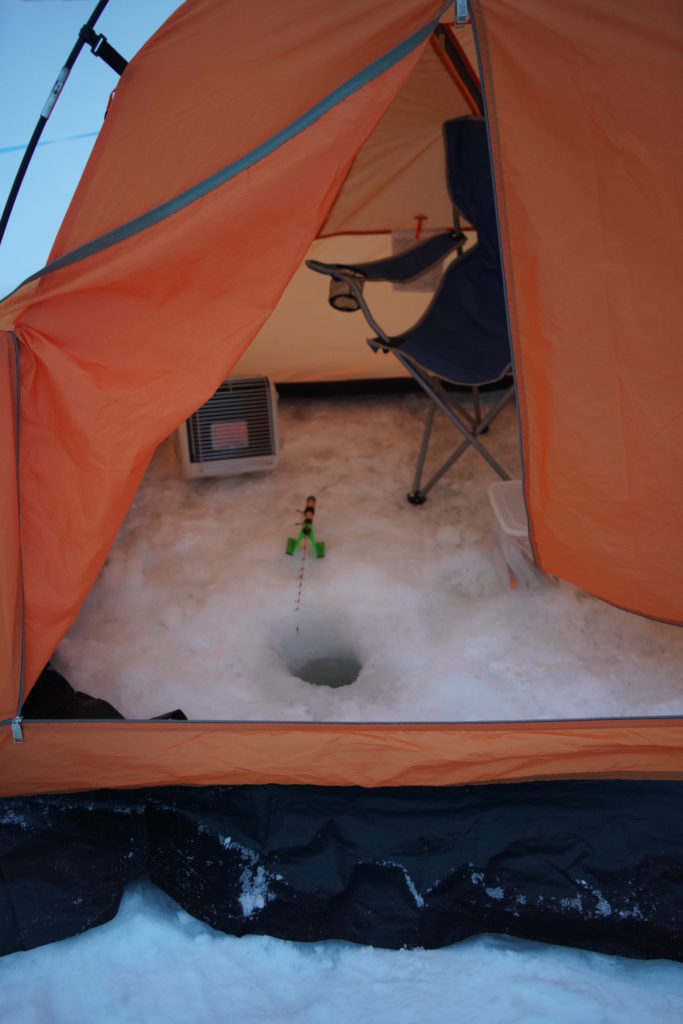
I got up and stretched my back when the bite slowed. As I looked around, most of the tents were covered in snow, but I could hear people excitedly catching fish inside.
When the snow once again picked up, I took cover inside the tent, which had cooled down again. As the outside got colder, the fish were ready to bite again and I gave them everything I could. The baited hooks were going down the hole in the ice and fish were coming up out of the hole as fast as I could handle it.
Just as the bite started to slow again, my rented heater ran out of propane. I still had about 45 minutes to fish but decided to head back before the snow got worse. The family next to me chatted with me for a bit when they saw how many I caught.
The smell of the fish they were cooking in their tent made me hungry (I had skipped breakfast to get to the lake early). Someone in the rental office asked me how many I had caught; honestly, I had no idea. I didn’t count them on the ice, but they did say it looked like a lot. -Lance Sawa
MARCH: Preparing For A Dog’s Last Hunt
A few hours later I put Kona in the truck and went to check on them. They had ducks and were happy, but solemn. I wanted to chat but respected their precious time. I petted their dog, watched her hunting instincts override her aging body, and looked into her eyes, with little conversation.
The dog was lying outside the blind, in some mud and rocks; she didn’t care that it was cold and uncomfortable, for this spot was easier for her to spot birds from than the dog blind I’d constructed. Her eyes grew big and her tail wagged when she saw ducks, or thought she saw ducks. One of my favorite things when duck hunting with dogs is watching their eyes and body language as they spot ducks. They spot way more than we do, and get more excited and tense with anticipation. They also scold us when we miss.
The aged dog had a retrieve while I was there and I was honored to see it. She moved slow and steady, but with purpose. Her long slow-wagging tail quickened as she approached the wigeon in chest-deep water. Water didn’t fly from her tail in tiny droplets, as I’m sure it once did.
The old girl ended up having a good day, and her eyes and body language confirmed it. She was in her happy place. Her owners were so appreciative, but quiet, and rightly so.

WHEN IT COMES TIME for my dogs’ last hunt, I want to be with them, just me. I want no one else around to think about or have to talk to because every precious second with them is valuable and passes all too swiftly. -Scott Haugen
MAY: Saving California’s Steelhead Runs
Farther south and not so very long ago, California was a steelhead mecca of fish-filled streams and unimaginably productive fishing. The home of early steelhead fly-fishing pioneers such as Bill Schaadt and Jim Pray, coastal California was the place to be in the 1950s and 1960s. Movie stars came to catch steelhead, national magazines devoted cover stories to this phenomenal fishery, and the annual records were dominated by fly-caught California steelhead. If you’re a true glutton for punishment, read Russell Chatham’s beautiful book The Angler’s Coast and see what the good old days were really like. Keep a box of tissues nearby.
In the 1960s, the Russian River averaged 50,000 wild steelhead per year. Today, a good year sees seven thousand. As agriculture, development, industrialization, and other human factors have come to dominate the California landscape, the steelhead have predictably responded by disappearing. The numbers are staggering.
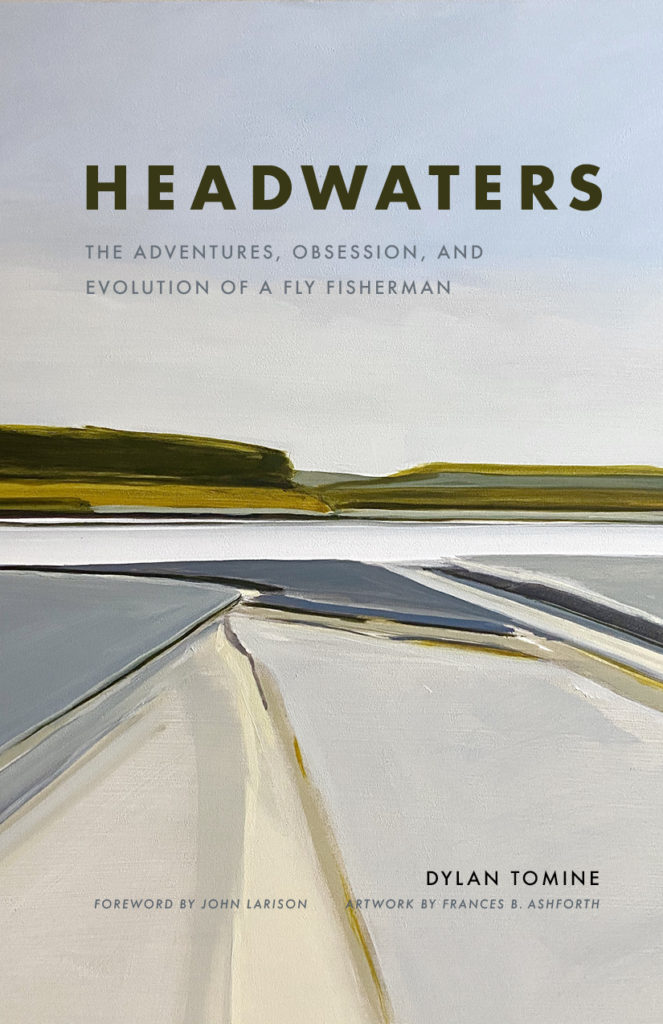
The Carmel River, a small Central Coast watershed, once hosted twenty thousand steelhead each year. In more recent times, the run has fallen to as low as 15 wild steelhead. In 1961, the mighty Sacramento–San Joaquin system had 40,000 spawning steelhead. Today, the annual fish count at the Red Bluff Diversion Dam on the Sacramento River, which carries the bulk of this once-prolific system’s steelhead population, averages 1,400.
California obviously has the most intense population issues on the coast, and has seen the most catastrophic losses of wild steelhead. But management of these precious fish would be absolutely hilarious if the results weren’t so sad. Even the mass-produced hatchery fish of the American River are hardly coming back. Despite enormous numbers of juveniles released each year, which used to result in a run of up to 19,000 fish in the 1970s, returns are now less than 1,000 fish.
The Ventura River, which once had a run of 5,000, now gets a return as low as 50 fish per year. As concerned locals petitioned to have the remnants of this run listed under the Endangered Species Act, the feds showed up claiming a need to obtain DNA samples to determine that Ventura River steelhead were in fact a distinct species. How many do you need, they were asked. “Fifty,” was the reply. The situation deteriorated into a standoff between armed State Fish and Wildlife officers protecting the fish from federal employees who needed to “take” fish in order to protect them. -Dylan Tomine
JUNE: Collins Lake’s Family Tradition Of Fun
When we got to the general store, I was able to finally meet Jacob in person after all our past calls and emails. We chatted about possibly coming back here to camp sometime – Ashley and David have a tricked-out trailer they camp with – and I asked him about what his family’s legacy means to him, his dad and grandfather who started this tradition of Youngs picking up from previous generations.
“I am definitely excited to see the family business legacy continue for hopefully generations to come. The oldest of the fourth generation is 11 years old, so it will not be too long before we start to see them working sea- sonally,” says Jacob Young, who has two young children himself.

“Whether it is my kids or members of the extended family, it will be ex- citing to watch how they all grow, de- velop and pursue their life paths. For those who choose to make this oper- ation their career, it will be surreal to be in the position to assist in the next cycle of generational passing over.”
Ashley and I took a stroll through the store, which offers visitors just about anything they might need, from bait and tackle to Collins Lake souvenirs, groceries, cold drinks – including a nice beer selection – and some great food. We had planned to eat lunch back in Rocklin, but we couldn’t leave without trying the Collins Lake ice cream that Ashley had tried on a previous day trip here and that Jacob highly recommended we indulge in.
“It began with Bob wanting to create memorable experiences for the guests coming to the campground. Ice cream became the vessel to provide something that dramatically exceed- ed expectations and left an impression that would be a memory and something to come back for year after year,” Jacob says. -Chris Cocoles
JUNE: Understanding The Bass Life Cycle
STUDY THE FISH
If you do not understand the life cycle of the largemouth, then you need to read more magazines or online articles like this, watch videos and visit all the seminars you can. But most of all, get out on the water year-
round so you can better understand the cycle of your favorite lake. The better you understand where the bass have gone, any time of year, the better a fisherman you will become.
Those breaking fish you were chasing only a couple months ago will just be hunting the same schooled-up shad or baitfish, but a little deeper in the lake. They are not gone; just a little harder to find and fish for.
This is where your electronics come in. If you don’t have electronics,
then you need to get something. If you are traditionally a renter of boats, then invest in a portable unit. It is one of the best things you can buy as a fisherman and it will make a world of difference.
Remember, the life cycle of the largemouth? Different times of year, different depths. If you can’t tell how deep the water is, then you may be fishing where there are no bass.

BLESSED BY GOOD WEATHER
In Southern California, we are spoiled with beautiful weather. In most other states, especially back east, it is cut and dry; either it’s warm weather or freezing weather. In our corner of the country we can stay on the lakes year-round, unless they close for conservation purposes. The better you get at handling this transitional time, the more you will want to be on the water for most of the 12 months.
Another thing to remember in this transitional time is that most lakes in the Southland plant trout during the cooler months to draw in another group of fishermen. This also bodes well for largemouth anglers, because the bass love to treat themselves to these tasty morsels. If you invest in some imitation trout lures, you will also have a chance of scoring a giant while you work through winter to the prespawn. -Bill Schaefer
AUGUST: Sturgeon Tagging For Conservation
In eight years of tagging since 2012, the Lodi office has implanted over 100 transmitters in white sturgeon. Among other things, their data will be used to inform the design of fish-passage improvement projects around dams and other obstructions that prevent fish from reaching potential habitat in the San Joaquin River system.
“Sturgeon don’t have the same jumping capabilities that salmon do. They stay closer to the bottom of the river, mostly as bottom-dwellers,” said Heather Swinney, San Joaquin River restoration program coordinator for the U.S. Fish and Wildlife Service. “Therefore, fish-passage improvement projects require a different level of design consideration to provide sturgeon passage under all water-year types and low-flow situations.”
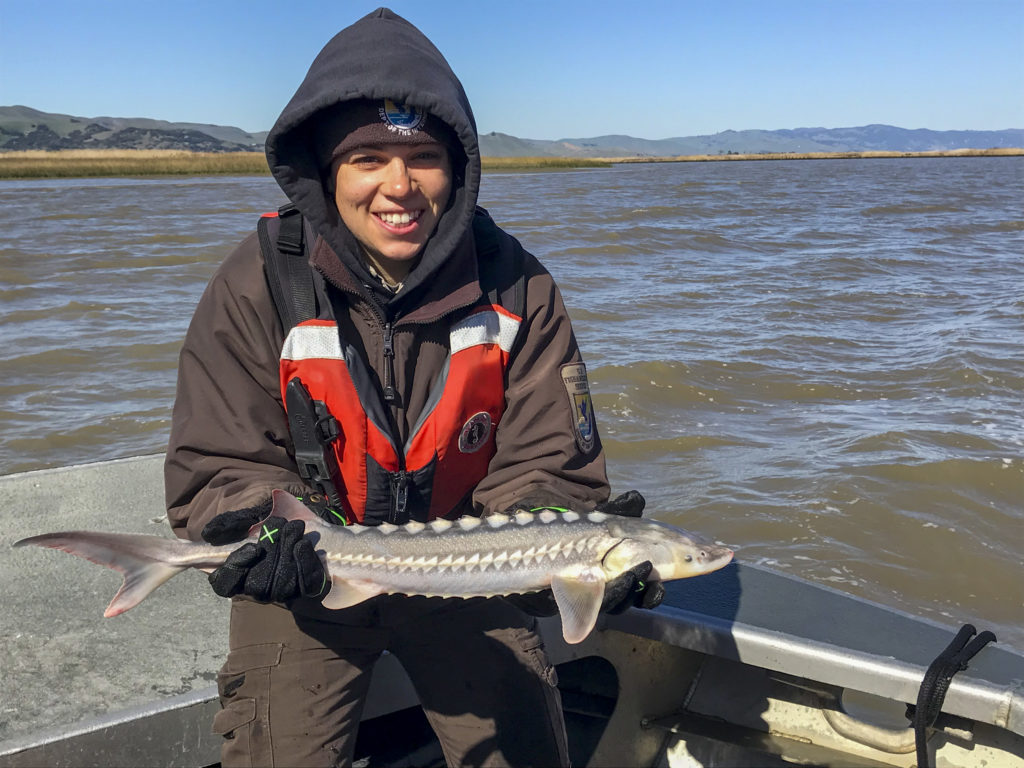
Due to the presence of Chinook salmon and the future potential of steelhead in the upper San Joaquin River basin, it is a priority for projects to provide fish passage for those species. Compared to salmon and steelhead, less is known about the white sturgeon migration patterns in the San Joaquin River system, or that of the threatened green sturgeon, which likely follow a similar pattern.
“We have so many questions regarding their use of habitat, spawning timing, survivorship, movement and response to water-operations management actions,” Swinney said. “Are sturgeon in this area? Are they heavily using this area, or are they only there in certain water-year types and certain situations? Without these movement and migration tracking projects, it would leave a data gap in what we know.”
In addition to aiding habitat-protection and restoration actions, the acoustic telemetry data will contribute to a growing body of information on habitat use that may one day help inform water-operation management decisions, including flow releases from dams and tributaries. -Brandon Honig
SEPTEMBER: Football Star Jared Allen’s Hunting Legacy
And as hunting has become more and more of a passion for Allen post- football, the notion of harvesting game inspired his and Amy’s restaurant venture, The Lodge Sasquatch Kitchen near the campus of Arizona State University in Tempe. Naturally, the eatery has a fishing/hunting lodge motif. (Jared has also penned a wild game recipe book, aptly named The
Quarterback Killer’s Cookbook).
Jared and Amy are both passionate about cooking (he loves to grill, she’s Italian and a whiz in the kitchen). But just as important is the type of food they’re putting into their bodies.
“We’re very into food – organic food. We’ve been on a pretty hardcore organic (diet) during the last five years or so. We’re conscious of putting quality food into our bodies. We’ve really gone down the rabbit hole in organic eating. I love to garden and love to grow as many vegetables as I can. So having that hunting lifestyle just adds the ability of knowing where your food’s going.”

He’s even trying to convince the kids to eat more wild game. “I had to kind of trick them at first, but now they know and eat venison burgers. I haven’t gotten them into venison steaks yet. They still draw the line on that,” says Allen, who someday will teach Brinley and Noel to shoot.
And if you’re hunting with him, there’s one other variable to remember. Want to harvest a monster animal? Fine. But it should be considered table fare more than a trophy.
“I think it’s important that I’m an avid kill-what-you-eat hunter. I’m not a sport hunter, though I love the sport of hunting, although I don’t really call it that. I love the activity of hunting,” Allen says.
“I don’t necessarily have to harvest something. For me, just being in the woods and the anticipation; trying to put a plan together and executing it on an animal. (But) you show respect by eating what you harvest.” -Chris Cocoles
OCTOBER: The Vision Quest Buck
Using the knob as a central landmark, I studied the area from every angle using Google Earth. The west face of Knob Ridge looked down on a spring-fed creek and seemed to be dominated by rimrock. About a quarter-mile south of the knob the ridge terminated into a drainage that featured an east-west-running creek that ultimately dropped into the main creek.
The junction of those creeks would be my jumping-off point. I’d travel cross country until I reached the junction, cross the main creek above the tributary, fill all my water bladders and then ascend Knob Ridge and set up a well-hidden camp. Come the last week of October, that’s exactly what I did.
I planned nine days for the hunt. The day before the season opened, I hiked for about six hours with a 60-pound pack and set up the tent for the night. Opening morning, I spent around two hours watching the area where I’d camped, listening to rifles popping off to the west. When things quieted down, I broke camp and was on the move again. …

The next morning, I settled in under the juniper while the stars were still shining bright. Working slowly, I set up my ultralight stove for some post-dawn coffee, followed in late afternoon by a dehydrated dinner. Unless I tagged a buck, I wouldn’t be leaving the cover of the stand until the sun was down. The spot was more comfortable than I expected; I could sit, stand and even lay down without showing myself.
Once the sun was up, I used my range finder to get a feel for the area, leaned my pack up against a rock to serve as a shooting rest, and then spent the rest of the day glassing. For the day I spotted 27 deer, including a pair of legal bucks, and a black bear. Both bucks and the bear would have been easy to harvest, but with all the planning and preparation I’d done, I wanted to invest some time in getting an exceptional buck. -Cal Kellogg
OCTOBER: Dam Removal Projects Decades In Making
CS 10-22.pdf
For the CalTrout duo of Mierau and Collins, the Eel and Klamath projects respectively have become labors of love. Mierau grew up in Southern California, but he and his family make their home near Six Rivers National Forest, the heart of some of the most pristine wilderness and rivers California has to offer.
Mireau calls the Smith the North Coast’s premier river, but he wants the Eel to be the stronghold that the Smith is for its region.
“I think the core reason that we do this is that restoring them to their full potential, where we can have that opportunity, is absolutely essential to life function,” Collins says of the Klamath and Eel. “The ecological importance of having a free-flowing river and restoring those ecological processes is essential to everything that CalTrout does.” (CALIFORNIA TROUT)
“It has that potential. We can get rid of the one hydropower project and the two dams, and make it entirely free-flowing, which is a rare thing across California. It is enormous in size and scale and has the capacity, right alongside the Klamath, for producing abundant fish that can support a commercial fishery and a recreational fishery,” he says. “And it has relatively undeveloped landscapes, so we can at this time turn the tide and make it ecologically resilient and make it be a really healthy watershed going into the future.”
Collins too has moved closer to the action. He now lives around the community of Mount Shasta and is adjacent to the stretch of the Klamath that is soon to be rid of its four dams. The Iron Gate, of course, has taken the biggest toll on migrating fish as the first obstacle heading up the Klamath.
“It’s brutal for a number of reasons. One, they’re taking really cold, clean water and damming it up. And Iron Gate in particular, you see a ton of cyanobacteria. It’s almost impossible to swim near those dam facilities across those four reservoirs,” he says. “They’re really toxic; you’ve seen a rise of parasites, including C. shasta, that have devastating effects. It’s really terrifying. We talk about the cultural importance and viewing the salmon as actually part of the culture within these tribal nations. It is a genocide when you see these fish kills.”
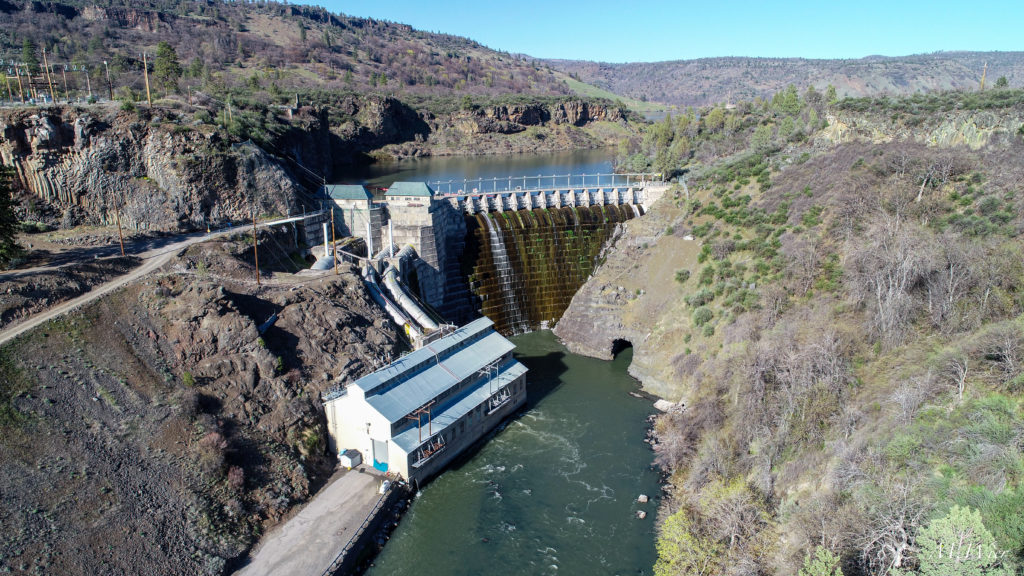
And for Collins, an avid fly fisherman, improving the quality of life for salmon and steelhead has made it all worthwhile all these years. The expectations are for construction to begin in late 2022 or early 2023, the removal of one of the Copco Dams to happen early next year and the other three taken down by 2024.
“When you work at nonprofits, you find people that are not motivated by money, primarily. We should all be paid as much as high- functioning for-profit companies, but that’s a different kind of problem to tackle,” he says. “I’ve always known I wanted to work in conservation. I was really lucky to be mentored by a lot of good close family and friends who really painted a clear picture of what you could do with conservation and the impact you could have, and the livelihood you could create for yourself and your family.” -Chris Cocoles



